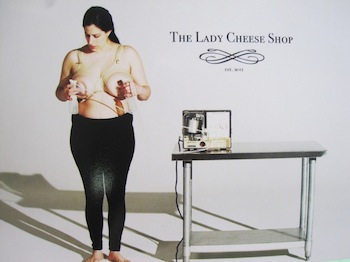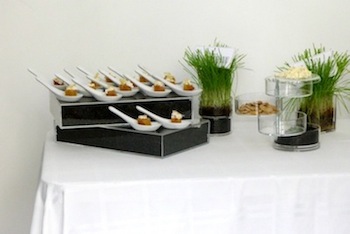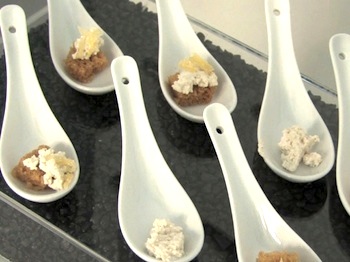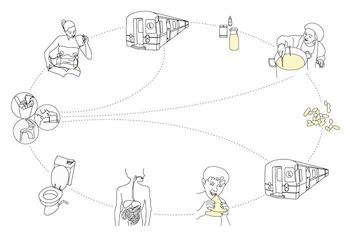Miriam Simun’s The Lady Cheese Shop, installed at Michael Mut Gallery in New York for four days between April and May, served up three different types of cheese at its opening reception and tasting. All made from local breast milk, Simun’s art des fromages, made in collaboration with Chef Sarah Hymanson, offered plenty food for thought.
Now when it comes to eating, I consider myself to be fairly adventurous. Watching those crazy food challenges on The Amazing Race, I like to believe that, if put to the test, I could stomach fried rodents better than most people. It seems that for some adults the thought of breast milk is just as disgusting. So perhaps part of me was excited by the sort of dare to eat Simun’s “human cheese.” And since I was born with a severe milk allergy (now long gone), I was quite conscious that in this itsy-bitsy gallery on the Lower East Side, I would come close to having an experience I missed, quasi connecting with a bosom as a source of nourishment. “Midtown Smoke,” the only cheese that was left when I arrived, was described as being “made from the milk of a young Chinese mother living in midtown Manhattan, and a goat hailing from Northern Vermont…” As soon as the curd touched my tongue and its smoky sweet flavor hit my taste buds, I nearly puked.
While local-sustainable proponents go on pontificating about the need for consumers to connect with their food, to better know the origins of what they eat, Simun’s work is tangible confirmation of how people’s choices might change with greater awareness. You see, it wasn’t the flavor of Midtown Smoke that made me feel ill. But later I realized, it was just too much information. Just think about all the things you put in your mouth day-to-day knowing absolutely nothing about its ingredients or manufacturing? Take, for instance, factory-farmed milk: if you picked up a carton at the local grocer that read, “Drawn from the udders of a hormone-filled cow that suffers daily,” would you still buy and consume it? And if you did, could you enjoy it just the same? “Facing the decision to ingest [human cheese],” Simun has written “materializes technological and ethical issues at hand.”
Breast milk concoctions have made headlines this past year; most notorious are “The Baby Gaga,” breast milk ice cream made by the London-based group The Icecreamists; and Mommy’s Milk Cheese, made by Chef Daniel Angerer of New York’s Klee Brasserie with the help of his lactating wife. Both enterprises have been criticized for lacking ethics, potentially endangering public health, and being nothing more than attention-hungry stunts. Simun’s project is not without similar flaws and criticisms.
Adverse to human cheese production has been food critic Robert Sietsema of the Village Voice. He suggests that the amount of breast milk needed to make this a viable commercial venture is impossible lest women be turned into farm animals and their milk taken away from babies who need them. Sietsema even goes as far as to relate the consumption of human cheese to cannibalism. This might go without saying to followers of Art21, but even if Simun’s objective were to turn The Lady Cheese Shop into a profitable business, as an art inquiry, the feasibility of doing so is secondary if not irrelevant.
In the art world, cheese is quite common; you can count on a plate of it at most openings. Breast-feeding too has been intimately presented many times before, such as in photographs by artists Catherine Opie and Vanessa Beecroft. Though rare is the occasion that viewers are offered a sample of “the gaga.” En route to The Lady Cheese Shop, I was fully aware that a certain shock value was driving me cross-town, in the rain, and in uncomfortable shoes, I might add, to taste this cheese. Of course, that sense of “shock” is entangled in the often tacit cultural taboo of consuming breast milk beyond infancy, and the perceptible unease some people feel at the very thought of a woman breast-feeding, especially in a public setting–as if the act is intentionally obscene. Simun and Hymanson together dismiss these ideas and beliefs by manipulating breast milk for the gustatory pleasure of grown-ups. The provocativeness, then, the thrilling complexity, and maybe even the “art” of The Lady Cheese Shop, is the cheese itself; and also in the distressing questions Simun uses it to pose: “As we welcome new technologies into our lives, how will we continue to redefine what is natural, normal, healthy, and ethical? If we reject all technologically modified food in favor of what it ‘natural,’ how far back do we go?” I would add, how twisted is it that by broad cultural and public heath standards we should be repulsed by breast milk cheese and not by the unnatural and chemical-laden foods we consume daily?
The Lady Cheese Shop wasn’t an entirely successful installation. Photographs and pieces of ephemera on the walls only seemed to fill space, adding little visually or in the way of concept. More effective was Simnu’s close-up video of a woman pumping, her nipples shown as they’re pulled into suction cups like taffy. Hooked up to a machine and standing there somewhat docile, one can’t help but see Sietsema’s reference to livestock. There is always something to be said about our different sensitivities to the bodies of animals and humans when it comes to food production.
As the shortcomings of our modern industrial food system become more visible, and threats of global food crises grow closer to becoming reality, it seems that artists are increasingly using their practice to think out loud about sustainable food production. How could they not? Problems of sustainability belong to every living person. “If you’re really going to try to eat organic, natural and local,” Simun was recently quoted saying, “there is nothing more local or natural than human cheese. New York has 8 million people and not one cow, so the mammals in your midst are human.” The Lady Cheese Shop might not offer a real long-term solution, but it’s a good place to start thinking about the future of food, and questioning the things we eat regularly without thinking twice about them.








Pingback: Open Enrollment | The ITP Class of 2011 | Art21 Blog